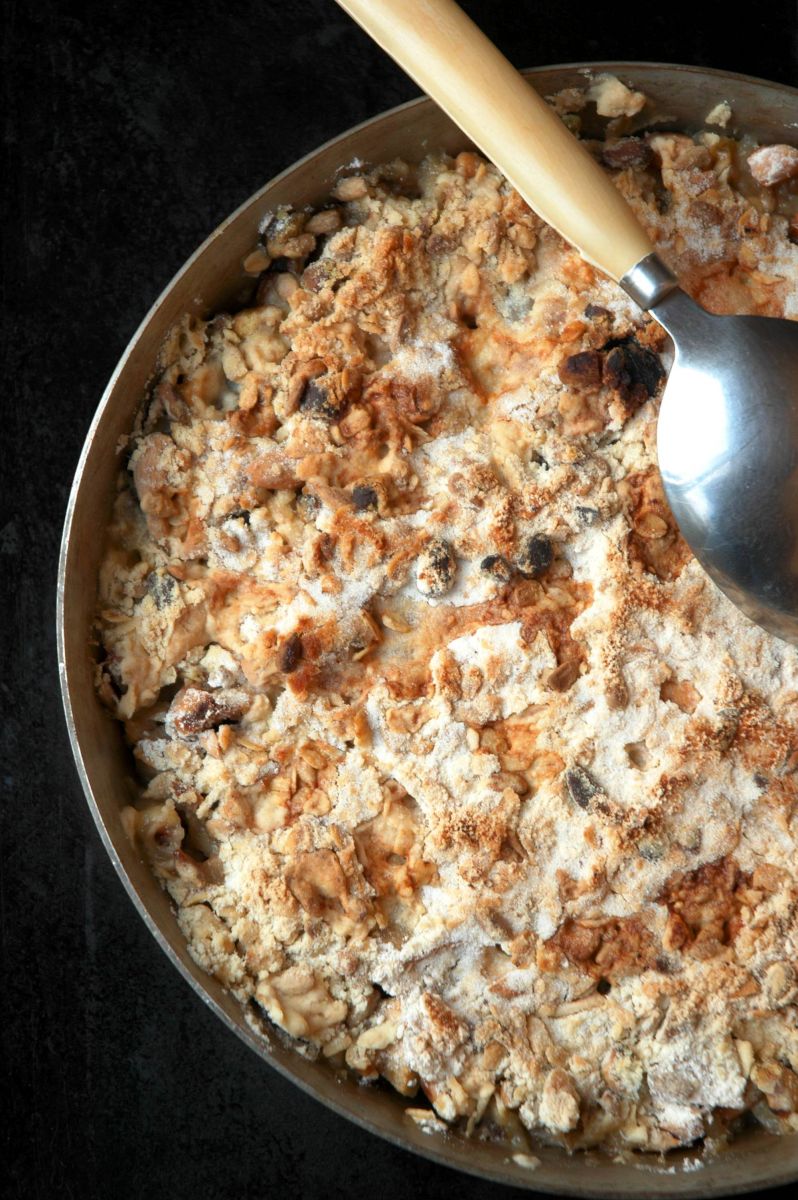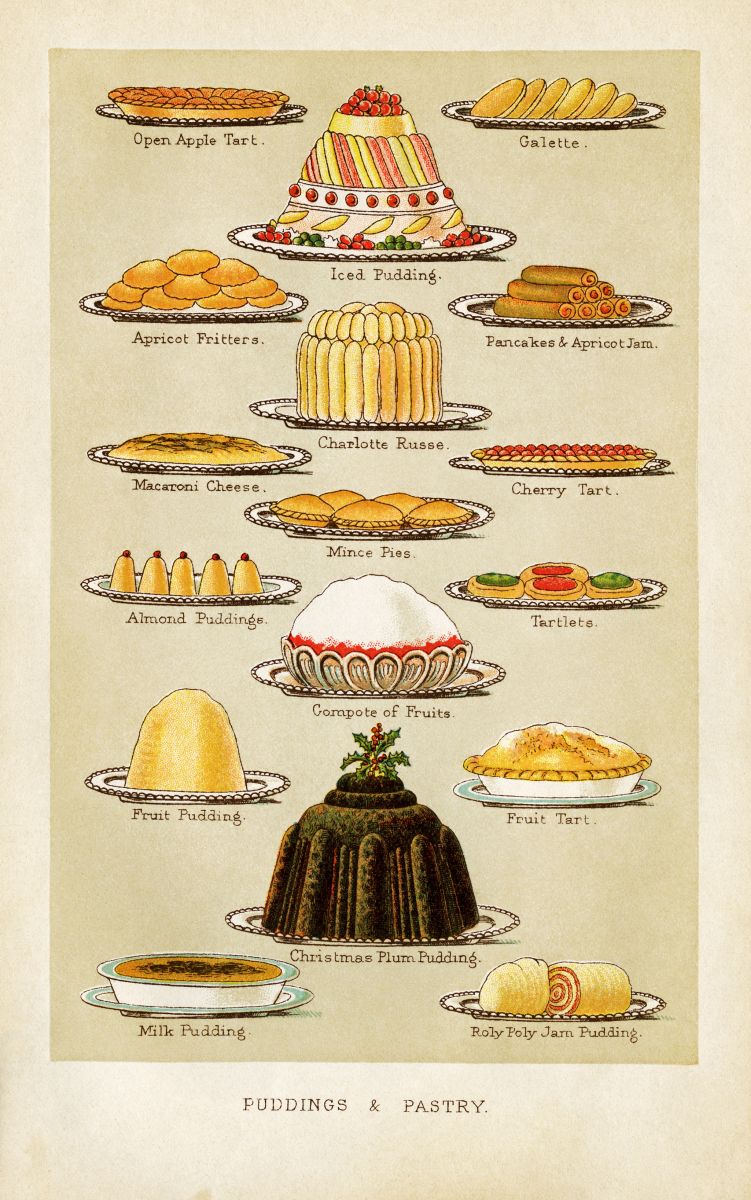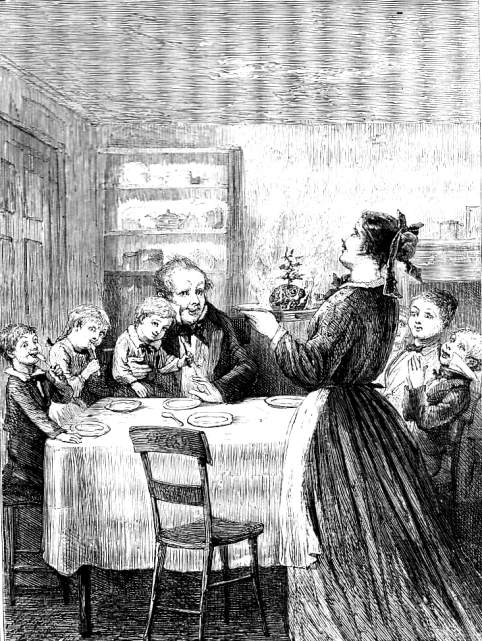Written for Anglotopia.com

What’s for pudding, Mum?
This question is asked on a daily basis across the British Isles where they are exceedingly fond of a good pudding. But what exactly is pudding and where did it come from? Coming from America, pudding means a creamy, custard-like mixture; pudding in England can mean a multitude of things. The esteemed Oxford English Dictionary definition runs nearly a third of page of minute type describing it as everything from “the stomach or intestine of a pig, sheep, etc. stuffed with minced meat, suet, oatmeal, seasoning, etc. , and boiled” to “a cooked dish of various sweet or savory ingredients, esp. as enclosed within a flour-based crust or mixed with flour, eggs etc., and boiled or steamed; a baked batter mixture. Now also, the sweet course of a meal.” From Blood Sausage, Yorkshire Pudding and Haggis to Eton Mess, Flummery and Spotted Dick, puddings in England run the gamut from spiced, offal-filled sausages to cream filled concoctions dotted with fruit. It’s understandable that one might get a little confused.
A short history of puddings.
Historians usually agree that the first puddings were savory sausages. The word is derived from the French word boudin (black pudding) which came from the Latin bollutus (sausage or small intestine). So how did we get from a sheep stomach filled with organs and oats to a fruit filled dessert? Modern technology was the answer, even in the early 1600s. With the arrival of a pudding bag or cloth, animal stomachs were no longer needed to boil various culinary concoctions, and English chefs went to town creating myriad sweet treats. The British became well known for their desserts—whether they were created to ward off the chill of British winters or to satisfy a national penchant for sweets—as noted in the late 1690’s by a French writer and traveler named Francois Maximillien Misson. They bake them in an oven, they boil them with meat, they make them fifty several ways: blessed be he that invented pudding for it is manna that hits the plates of all sorts of people; a manna, better than that of the wilderness, because the people are never weary of it. Ah, what an excellent thing is an English pudding!
 By the nineteenth century, puddings had expanded from those made with suet and usually boiled, to include sponge puddings, all manner of dishes made with bread, flans, batters and meringues. Boiling was no longer the only cooking method as more homes had ovens. Indeed some puddings were not cooked at all. For example Summer Pudding consists of a bowl lined with berry-juice-soaked bread and then filled with summer berries. This dish, once popular in health spas, was originally known as the rather unpleasant sounding hydropathic pudding—dessert for those on a diet if you will. Thankfully it was renamed and is still known as Summer Pudding today.
By the nineteenth century, puddings had expanded from those made with suet and usually boiled, to include sponge puddings, all manner of dishes made with bread, flans, batters and meringues. Boiling was no longer the only cooking method as more homes had ovens. Indeed some puddings were not cooked at all. For example Summer Pudding consists of a bowl lined with berry-juice-soaked bread and then filled with summer berries. This dish, once popular in health spas, was originally known as the rather unpleasant sounding hydropathic pudding—dessert for those on a diet if you will. Thankfully it was renamed and is still known as Summer Pudding today.
“English puddings have been famous for hundreds of years, and rightly so.” writes Arabella Boxer in her Book of English Food (1991). Her book is filled with such delights as Apple Hat, Castle Puddings and the famous Bakewell Pudding. The latter is synonymous with the town of Bakewell in the Peak District. It’s actually a tart—the shell is filled with a layer of jam, usually raspberry, and then topped with an egg-almond filling. The first known printed recipe dates back to the early 1830s and is still enormously popular today. Bakewell is located near Chatsworth House, home of the Devonshire family. In 2003 the Duchess of Devonshire and the chefs at Chatsworth House wrote a cookery book in which one finds a number of very traditional puddings, including one for Apple Compote with Black Treacle and Devonshire Cream. The Duchess describes the compote as, “This is all a pudding should be – sweet, sour and creamy. Black treacle is the same thing as molasses – good for horses and for us!” No wonder treacle puddings are so popular and apparently the Mayor of London’s favorite dessert as well as Harry Potter’s.
Fruit have always played an important part in English desserts from flavoring creams, known as “fools,” to pie fillings. You’ll find, for instance, across the British Isles, many apple-filled puddings including Apple Goody. In 1961, Helen Cox described the dish in her book Traditional English Cooking as follows “This is an old English recipe that is as Goody as it sounds… it could be a dangerous rival to the well-established Apple Pie.” The English are very fond of their apples, in particular the marvelous Bramley’s. They are only grown commercially in the United Kingdom, so much so that ninety-five percent of all cooking apples sold in Britain are this variety. British cookery books describe all sorts of apple dishes including apple crumble, made popular during WWII, created due to rationing of butter for more traditional pies. While reading about crumbles, I came across this wonderful whimsical description by Hugh Fearnley-Whittingstall: These homey puds are certainly not fine patisserie. They’re designed not to seduce the eye so much as to have rural rumpy-pumpy with your tastebuds. And they’re perfect for the pastry-challenged. There’s no rolling, no wrestling with tricky dough, no blind baking. Just a bit of chopping and mixing stands between you and hot, fruity pleasure. The crumble is, rightly, a national institution. So it’s surprising that we’ve only really been making them since the second World War. We’ve even exported them to France, where they can’t get enough of “le crumble.” Our humble, bumbling, tummy-rumbling crumble now rubs shoulders with crème brûlée and tarte au citron. And so it should. Marvelous isn’t it!
This is a variation of the crumble my mum taught me to make when I was little. It makes me want to brew a pot of tea, grab a good book, sit by a fire and enjoy a ‘tummy-rumbling’ crumble.
Serves 8 to 10 people
4 pears – peeled and chopped
4-5 apples – peeled and chopped
1/2 cup golden flame raisins
Juice and zest of 1 lemon
1/2 cup water
2 cups flour
8 oz butter (2 sticks) – cut into little pieces
1/3 cup toasted sunflower seeds
1/4 cup roasted pistachios – roughly chopped
1/3 cup rolled oats
1/3 cup almonds – roughly chopped
3 tablespoons sugar
1. Preheat the oven to 400 degrees.
2. Place the chopped fruit, raisins and lemon zest in a deep oven-proof baking dish. Pour the lemon juice and water over the fruit.
3. Place the flour and all but 1 tablespoon of the chopped butter in a large mixing bowl. Mix the butter into the flour using your fingertips until it resembles coarse breadcrumbs. Don’t worry if there are lumps of butter. It should look like that. Add the sunflower seeds, pistachios, oats, almonds and 2 tablespoons of sugar and stir well to combine.
4. Spoon the crumble mixture over the prepared fruit. Dot the surface of the crumble with remaining pieces of butter and sprinkle the remaining sugar on top.
5. Bake in the center of the oven for 40 minutes or until golden brown. Serve warm. It’s also really good with a dollop of creme fraiche or vanilla ice cream.
The 1890 edition of Isabella Beeton’s Book of Household Management lists hundreds of puddings, of which there are no less than six versions of Bread Pudding. They all include soaking the bread in a liquid, usually milk, and then pouring a spiced egg batter over the top and baking it. It’s perfect for using up day old bread. Versions of this type of pudding date back hundreds of years and exist all over Europe. Evidently, everyone has had the same idea of mopping up all the good juicy bits in the bottom of a platter or using the bread (trenchers, sops and focaccia) as part of a dish.
No discussion of British desserts would be complete without delving into steamed puddings of which Spotted Dick is one of the most well-known, if only because of its quirky name. This pudding was first written about in 1849 by the famed French chef Alexis Soyer, then at the helm of The Reform Club in London. The pudding—sometimes known as “spotted dog” or “plum bolster”—is a steamed spongy dessert made with flour and suet, spotted with fruit, usually dried currents and sultanas. There have been many discussions about its name, one of which is that the “Dick” in Spotted Dick comes from the shortened old English or Scottish name for pudding: puddog or puddick. There are other more risqué definitions! It is similar to a Roly-Poly, a pudding familiar to anyone who has read Beatrix Potter’s The Tale of Samuel Whiskers.
But perhaps the most famous pudding of all is Christmas Pudding. Traditionally served  on Christmas Day, this pudding takes weeks, in many cases, months to mature before it is served. It consists of a large assortment of dried fruit that is mixed with suet, spices, treacle, egg and brandy or other alcohol. These puddings used to be boiled in a pudding cloth, hence the cannonball shape you may see in old engravings or paintings that predate the Victorian era. They are now made in pudding bowls that are wrapped and steamed. Charles Dickens described the arrival of the pudding in A Christmas Carol (1843). "Mrs Cratchit left the room alone -- too nervous to bear witnesses -- to take the pudding up and bring it in ... In half a minute Mrs. Cratchit entered -- flushed, but smiling proudly -- with the pudding, like a speckled cannon-ball, so hard and firm, blazing in half of half-a-quarter of ignited brandy, and bedight with Christmas holly stuck into the top.” It’s a scene that has changed little over the past two centuries.
on Christmas Day, this pudding takes weeks, in many cases, months to mature before it is served. It consists of a large assortment of dried fruit that is mixed with suet, spices, treacle, egg and brandy or other alcohol. These puddings used to be boiled in a pudding cloth, hence the cannonball shape you may see in old engravings or paintings that predate the Victorian era. They are now made in pudding bowls that are wrapped and steamed. Charles Dickens described the arrival of the pudding in A Christmas Carol (1843). "Mrs Cratchit left the room alone -- too nervous to bear witnesses -- to take the pudding up and bring it in ... In half a minute Mrs. Cratchit entered -- flushed, but smiling proudly -- with the pudding, like a speckled cannon-ball, so hard and firm, blazing in half of half-a-quarter of ignited brandy, and bedight with Christmas holly stuck into the top.” It’s a scene that has changed little over the past two centuries.
There are regional puddings, seasonal puddings and everyday puddings. Ask any Brit about their favorite pud and you will get a hundred different delicious answers. So, what’s yours?